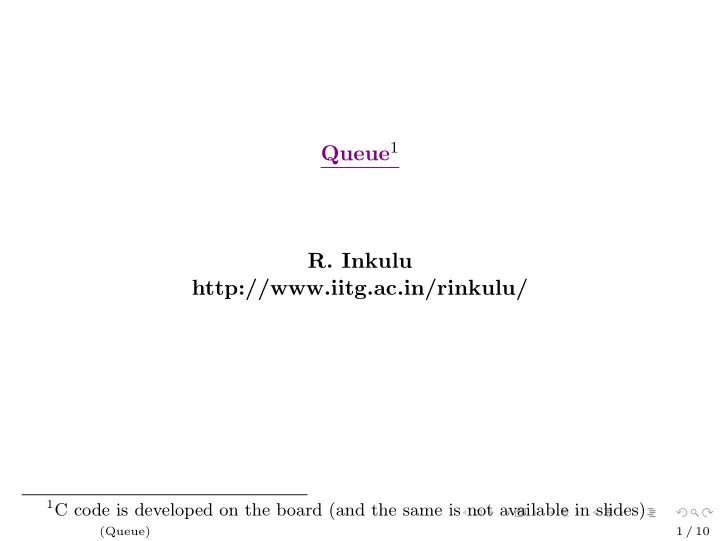

Queue 1 R. Inkulu http://www.iitg.ac.in/rinkulu/ 1 C code is developed on the board (and the same is not available in slides) (Queue) 1 / 10
Introduction • Motivation for First-In-Fist-Out (FIFO) data structure job scheduling message buffers • Essential operations to be supported include: enqueue an element to queue dequeue an element from queue (Queue) 2 / 10
Fixed-size queue #define QUEUESIZE 1000 typedef struct { void *p[QUEUESIZE]; int head; //p[head] is the element to be dequeued int tail; //enqueued element is placed at p[tail] } Queue; int initialize(Queue *q); int enqueue(Queue *q, void *data); void *dequeue(Queue *q); (Queue) 3 / 10
Fixed-size queue #define QUEUESIZE 1000 typedef struct { void *p[QUEUESIZE]; int head; //p[head] is the element to be dequeued int tail; //enqueued element is placed at p[tail] } Queue; int initialize(Queue *q); int enqueue(Queue *q, void *data); void *dequeue(Queue *q); • drawback in viewing p [] as a linear array: overflow may occur while many entries in p [] are not utilized (Queue) 3 / 10
Fixed-size circular queue 2 h t h t head can precede tail, and vice versa • array p in the queue data structure (mentioned above) is viewed as a circular • move head and tail over p [] using modular arithmatic 2 considered to be the default queue: the word circular may not always be mentioned (Queue) 4 / 10
Fixed-size circular queue (cont) h h t indicates queue is empty (reset tail to − 1 and head to 0) t h indicates queue is full (Queue) 5 / 10
Worst-case time complexity • enqueue: O (1) time and O (1) space • dequeue: O (1) time and O (1) space (Queue) 6 / 10
Dynamic-sized circular queue typedef struct { int capacity; int head; //p[head] is the element to be dequeued int tail; //enqueued element is placed at p[tail] void **p; //p is a pointer to an array of void *s } Queue; int initialize(Queue *q, int initialCapacity); int destroy(Queue *q); int enqueue(Queue *q, void *data); void *dequeue(Queue *q); (Queue) 7 / 10
Dynamic-sized circular queue t h t h resize when the queue is full • when the overflow occurs, double the size of buffer pointed by p • when the queue is one-quarter full, halve the size of buffer pointed by p ← homework • in both of these cases, avoid using realloc (which implicitly frees old buffer) instead use malloc and explicitly free the old buffer (Queue) 8 / 10
Deque data structure having provision for adding/removing at either of its ends is known as a doubly-ended queue (a.k.a. deque 3 ) homework: implement the dynamic-sized deque 3 ’deque’ pronounced as ’deck’ (Queue) 9 / 10
Stack using Queue, and vice versa Homework: • Implement Stack using Queue and analyze the asymptotic time and space complexities of the resultant push and pop • Implement Queue using Stack and analyze the asymptotic time and space complexities of the resultant enqueue and dequeue (Queue) 10 / 10
Recommend
More recommend